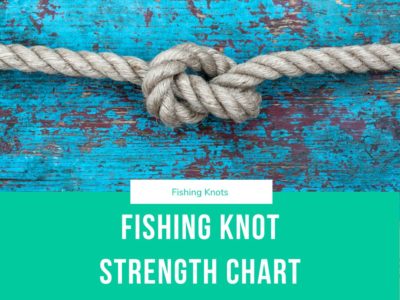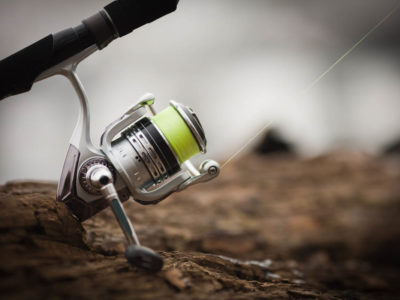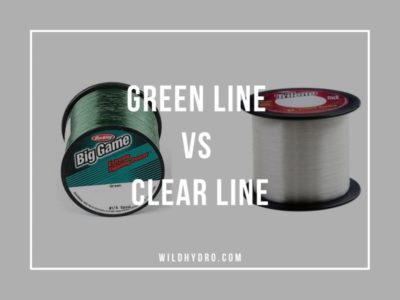All good anglers have a set of trusty fishing knots up their sleeve that they rely on in different situations. Deep sea fishing for tuna or sailfish needs a different knot to fly fishing for trout and salmon. Tying on a chatterbait uses a different knot to adding a leader for fishing minnows.
But do you really know why you use the fishing knot that you do. Is it just because that is how your granddaddy taught you way back when?
Check out our Fishing Knot Strength Chart which compares a variety of different knots and their breaking strength. We look at over 20 different types of fishing knots and see how strong they are when tied on braided, monofilament and fluorocarbon fishing line.
Table of Contents
Fishing Knot Strength Chart
The fishing knot strength chart provided here is a result of a series of scientific tests conducted by North American Fishing over a number of years. Each fishing knot was tested to breaking point in a series of videos posted online, and if you want to see exactly how they went about testing each fishing knot then I recommend you check out the NAF YouTube Knot War series.
But if you’d rather just see the results, I’ve documented each knots strength for you in an easy to read Fishing Knot Strength Table below.
| Rank | Fishing Knot Name | Knot Type | Mono | Fluoro | Braided | Avg. Fishing Knot Strength |
|---|---|---|---|---|---|---|
| 1 | Berkeley Braid Knot | Hitch | 132.1% | 131.3% | 124.0% | 129.1% |
| 2 | Fish ‘N’ Fool Knot | Hitch | 136.9% | 101.4% | 138.9% | 125.7% |
| 3 | Burke Knot | Hitch | 128.8% | 109.9% | 133.0% | 123.9% |
| 4 | Triple Loop Knot | Hitch | 123.3% | 131.6% | 114.8% | 123.2% |
| 5 | Reverse Improved Clinch Knot | Hitch | 117.8% | 109.7% | 135.4% | 121.0% |
| 6 | San Diego Jam Knot | Hitch | 118.4% | 101.7% | 127.4% | 115.8% |
| 7 | Miller Knot | Hitch | 134.2% | 99.6% | 111.9% | 115.2% |
| 8 | Palomar Knot | Hitch | 115.8% | 100.7% | 124.0% | 113.5% |
| 9 | Grinner Knot | Hitch | 114.0% | 99.3% | 125.0% | 112.8% |
| 10 | Porter Knot | Hitch | 132.6% | 125.1% | 77.6% | 111.8% |
| 11 | Cheek Knot | Hitch | 128.5% | 106.5% | 99.6% | 111.5% |
| 12 | Eugene Bend Knot | Hitch | 118.5% | 97.6% | 112.1% | 109.4% |
| 13 | King Sling Knot | Loop | 94.7% | 116.8% | 112.6% | 108.0% |
| 14 | Trilene Knot | Hitch | 117.2% | 99.8% | 102.3% | 106.4% |
| 15 | Gryp Knot | Hitch | 118.7% | 95.3% | 104.9% | 106.3% |
| 16 | Three G Knot | Hitch | 125.5% | 104.9% | 69.4% | 99.9% |
| 17 | McNally Loop | Loop | 102.1% | 84.7% | 100.4% | 95.8% |
| 18 | Compound Loop | Loop | 106.1% | 79.5% | 77.4% | 87.7% |
| 19 | Improved Clinch Knot | Hitch | 107.5% | 93.4% | 51.6% | 84.1% |
| 20 | Non-Name Homemade Knot | Hitch | 114.1% | 99.4% | 37.3% | 83.6% |
| 21 | Hangman’s Knot | Loop | 101.8% | 99.2% | 35.0% | 78.7% |
| 22 | Homer Rhode Loop Knot | Loop | 88.3% | 70.4% | 56.2% | 71.6% |
And for those of you who are a little more visual, here is the fishing knot strength chart which ranks the strongest fishing knot to the weakest.
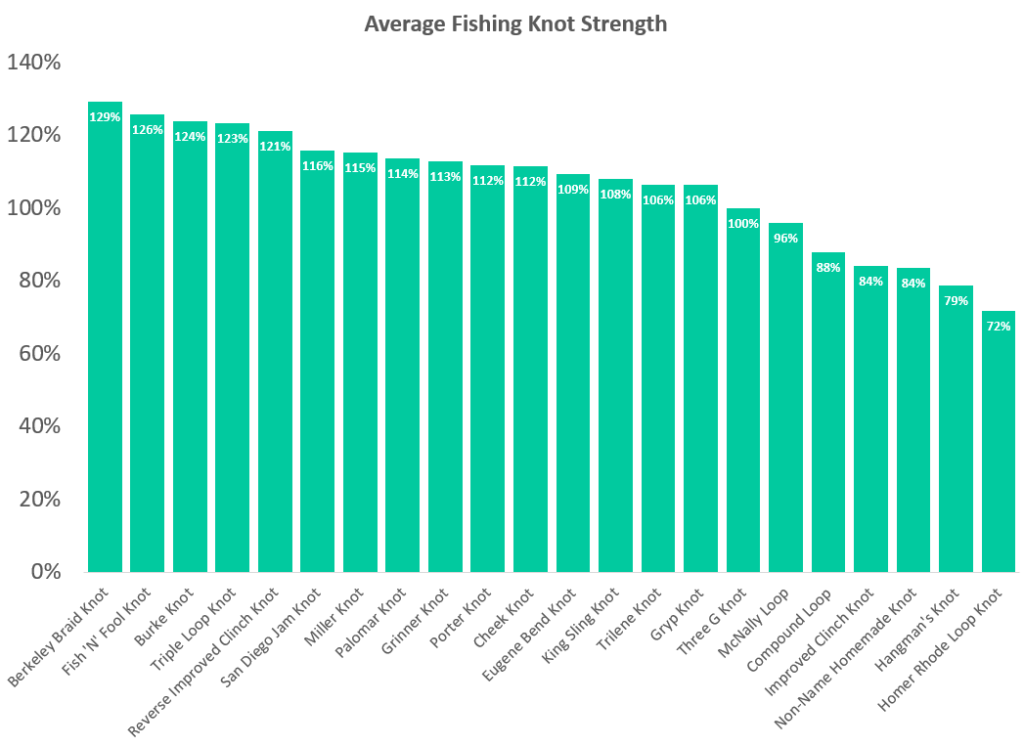
Knot Strength Testing Methodology
Each fishing knot’s strength was tested scientifically on a special machine provided by Berkeley, who are a well known fishing brand in the industry.
Knots on three different types of fishing line were strength tested:
- Monofilament Fishing Line
- Braided Fishing Line
- Fluorocarbon Fishing Line
The results of each knot strength presented on the Fishing Knot Strength Chart are presented as percentages so that you can see the relative strength of each knot to one another.
The calculation used to come up with the percentage looks at the strength of the fishing line that was tested and compares it to the tension that the line breaks at during the scientific test.
Let’s use a practical example to show you how the calculation works:
- Take 10lb Braided Fishing Line, which means the line should take 10lb of pressure before breaking
- Tie a knot in the line (we’ll call this knot the Wild Hydro knot just for this example)
- Use the testing machine to apply tension to the line and measure at what pressure knot breaks
- In this example, say the knot breaks when 11 pounds of tension are applied
Now you can calculate the strength efficiency that appears in the Fishing Knot Strength Chart.
- % Strength = Breaking Tension / Line Rating * 100
- % Strength = 11lb/10lb * 100 = 110%
In the above example, our Wild Hydro Fishing Knot has a strength of 110%. This means that the fishing line performs above expectations with the Wild Hydro Fishing Knot tied.
Hitch Knots vs Loop Knots
One thing that is very obvious from the strength testing is that Loop knots are nowhere near as strong as hitch knots. Now I know that sometimes you will want to tie on a loop knot to give your lure that extra degree of freedom of movement at the end of the line, but given the fishing knot strength test results shown here you need to be careful.
You are much more likely to have your fishing knot break when you use a loop knot than when you use a hitch. Play it safe and tie a hitch knot (or learn how to!) for most situations.
Strongest Fishing Knot for Fluorocarbon Line
The results of the strength tests show that the strongest fishing knot for fluorocarbon line is the Triple Loop Knot. This knot has a strength efficiency of 131.6%, which means that you can expect to get up to 31.6% more strength out of your fluorocarbon line above the rated poundage.
The second strongest fishing knot for fluorocarbon line is the Berkeley Braided Knot, with a strength efficiency of 131.3%.
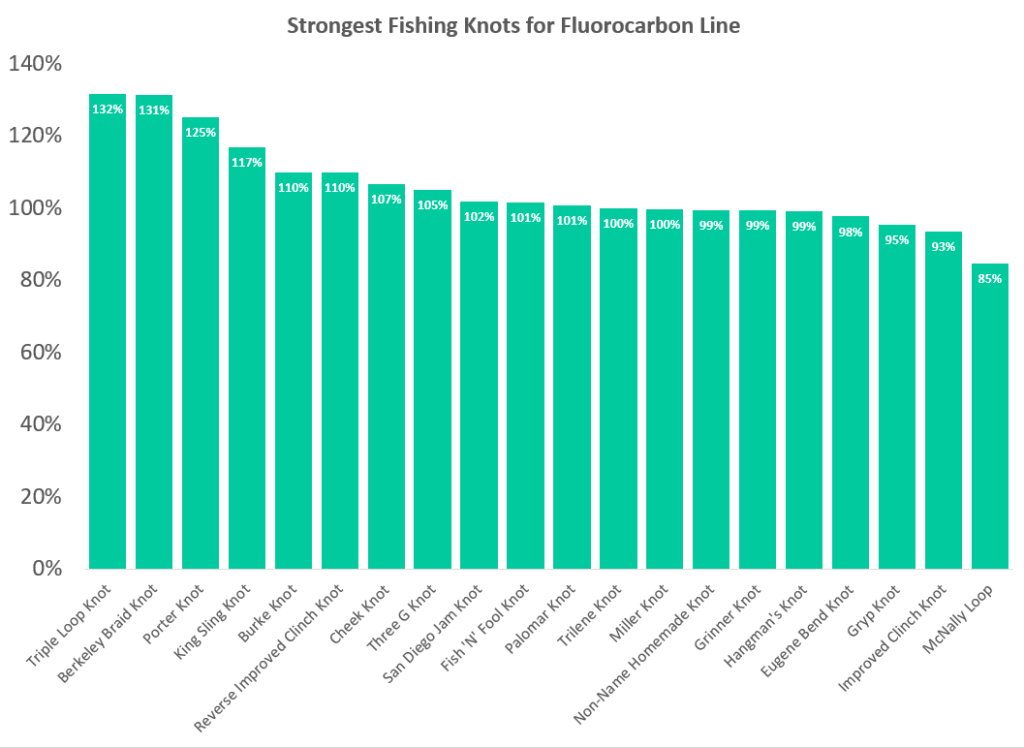
You can fish with confidence using fluorocarbon fishing line with either the Triple Loop Knot of the Berkeley Braided Knot holding your tackle on.
Top 5 Strongest Fishing Knots for Fluorocarbon Line
The best fishing knots for fluorocarbon line based on our fishing knot strength chart are:
- Triple Loop Knot
- Berkeley Braided Knot
- Porter Knot
- King Sling Knot
- Burke Knot
Strongest Fishing Knot for Monofilament Line
The findings of the strength testing found that the strongest fishing knot for monofilament line is the Fish ‘N’ Fool Knot. This knot has a very high strength efficiency of 136.6%, meaning you can potentially get up to 36.6% more strength out of your mono line that what it is rated for.
The second strongest fishing knot for monofilament line is the Miller Knot, with a strength rating of 134.2%.
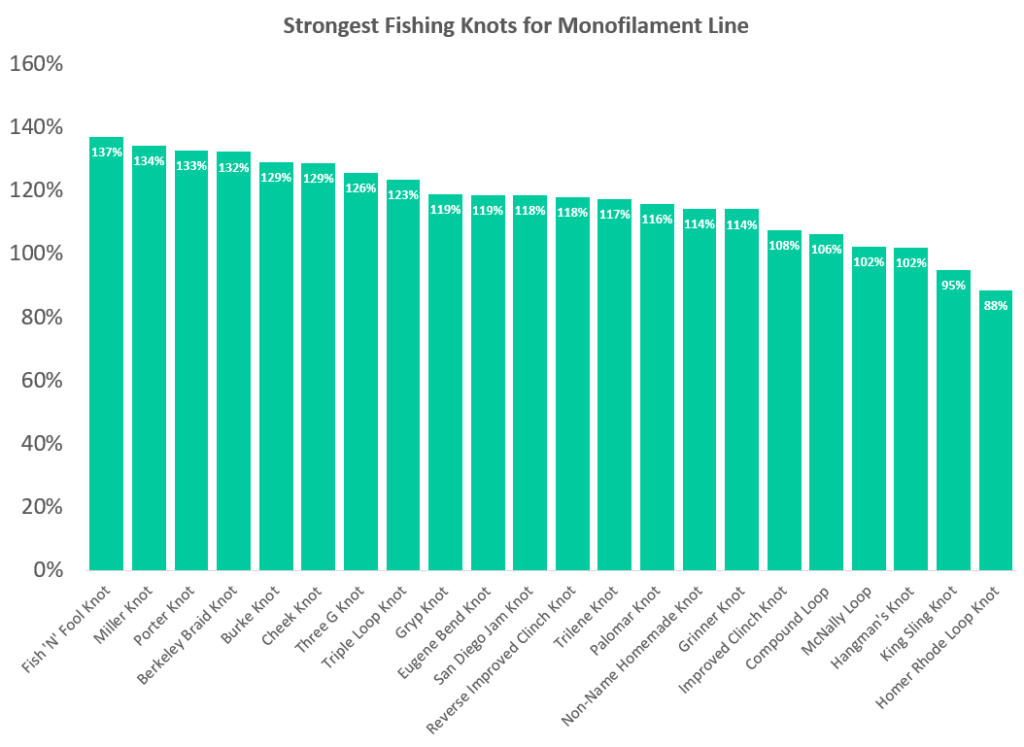
When hitting the water with monofilament fishing line, tying either the Fish ‘N’ Fool knot or the Miller Knot will keep your fishing tackle safe.
Top 5 Strongest Fishing Knots for Monofilament Line
The best fishing knots for monofilament line according to our fishing knot strength chart are:
- Fish ‘N’ Fool Knot
- Miller Knot
- Porter Knot
- Berkeley Braid Knot
- Burke Knot
Strongest Fishing Knot for Braided Line
The outcome of the strength tests demonstrated that the strongest fishing knot for braided line is the Fish ‘N’ Fool knot. This knot has the highest strength efficiency reading recorded out of all the fishing knot tests at 138.9%. You will get up to 38.9% extra strength out of your braided line when using the Fish ‘N’ Fool knot.
The second strongest fishing knot for braided line is the Reverse Improved Clinch Knot, which tested at a strength rating of 135.4%.
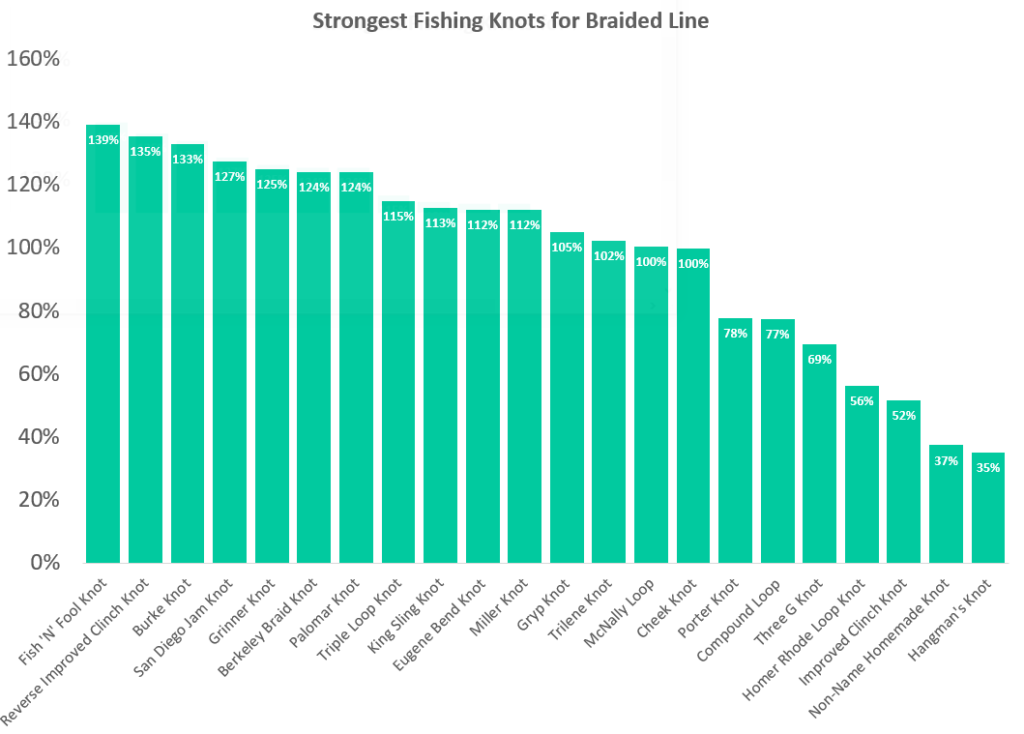
Both the Fish ‘N’ Fool and the Reverse Improves Clinch Knots are the most reliable knots to use when fishing with braided line.
Top 5 Strongest Fishing Knots for Braided Line
The best fishing knots for braided line based on the data from our fishing knot strength chart are:
- Fish ‘N’ Fool Knot
- Reverse Improved Clinch Knot
- Burke Knot
- San Diego Jam Knot
- Grinner Knot
The Last Cast
Nothing spoils a day out on the water more than when you lose a fish that you’ve waited all day for because your fishing knot fails you.
There is nothing more frustrating!
Don’t get stuck in the past using word of mouth to decide on which fishing knots are the strongest. It’s the 21st century and you should base your decisions on data. Our fishing knot strength chart shows you exactly which knots are the strongest knots to use when fishing with braided, monofilament or fluorocarbon line.
Stop using weak knots and start tying strong fishing knots!
Editor’s Picks
